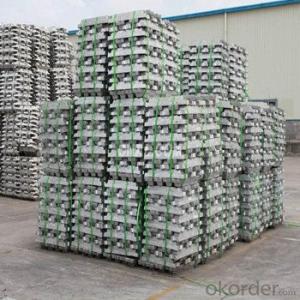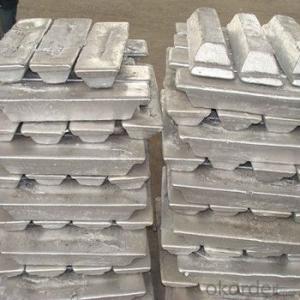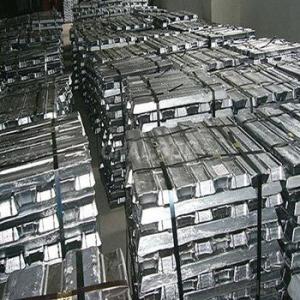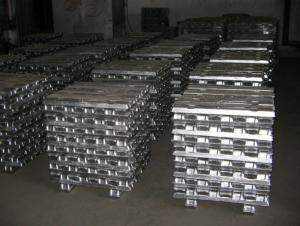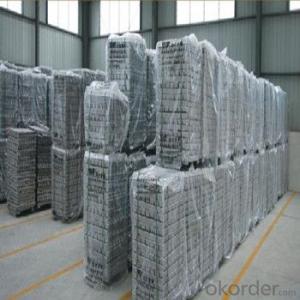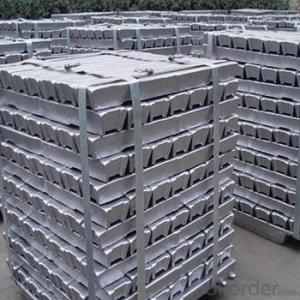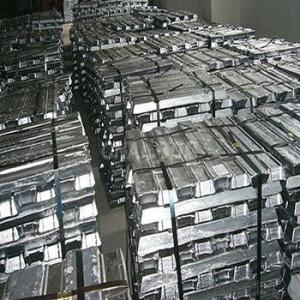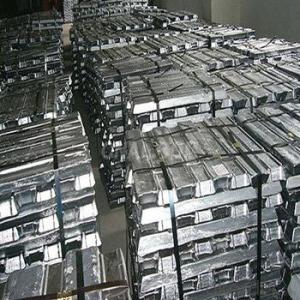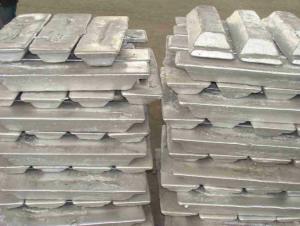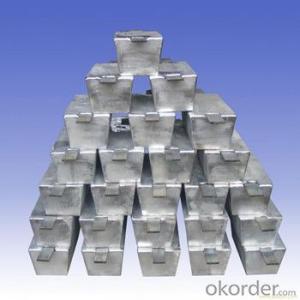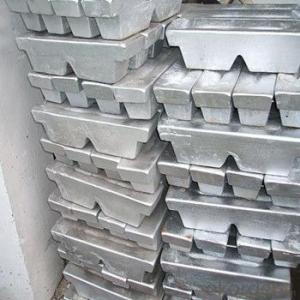Aluminum Pig/Ingot Used For Industry From China
- Loading Port:
- China main port
- Payment Terms:
- TT OR LC
- Min Order Qty:
- 1000 m.t.
- Supply Capability:
- 100000 m.t./month
OKorder Service Pledge
OKorder Financial Service
You Might Also Like
Pure Aluminum Pig/Ingot Used for Industry
1.Structure of Aluminum Pig/Ingot
A material that has been cast into a shape in order to be transported and processed easier than in an unprocessed form. An ingot is typically rectangular in shape, which allows it to be stacked. Ingots are most commonly associated with metals, with ingots of gold held in the vaults of banks and brokerages being popular images.
Aluminum Ingot is with the AL as the main chemical composition.Aluminum Ingot is used for industry,such as automobile,pinning and weaving,electron broadly and so on. Aluminum Ingot has the following advantages: easy control and operation, fast melting.
2.Main Features of the Aluminum Pig/Ingot
•High Purity
•Easy control and operation
•High strength
•Fast melting
•Competitive price
•Best Service
3.Aluminum Pig/Ingot Images
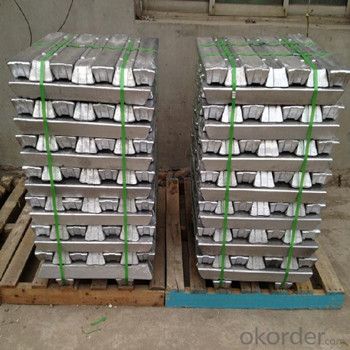
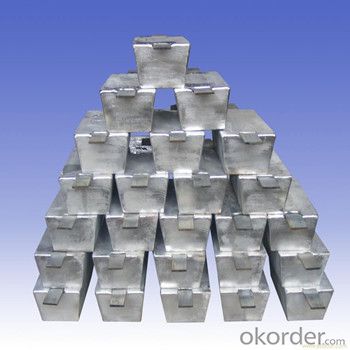
4.Aluminum Pig/Ingot Specification
Grade | Chemical Composition % | |||||||||
Al≥ | impurities ≤ | |||||||||
Si | Fe | Cu | Ga | Mg | Zn | Mn | others | Sum | ||
Al99.9 | 99.90 | 0.50 | 0.07 | 0.005 | 0.02 | 0.01 | 0.025 | - | 0.010 | 0.10 |
Al99.85 | 99.85 | 0.80 | 0.12 | 0.005 | 0.03 | 0.02 | 0.030 | - | 0.015 | 0.15 |
Al99.7 | 99.70 | 0.10 | 0.20 | 0.010 | 0.03 | 0.02 | 0.030 | - | 0.030 | 0.30 |
Al99.6 | 99.60 | 0.16 | 0.25 | 0.010 | 0.03 | 0.03 | 0.030 | - | 0.030 | 0.40 |
Al99.5 | 99.50 | 0.22 | 0.30 | 0.020 | 0.03 | 0.05 | 0.050 | - | 0.030 | 0.50 |
Al99.00 | 99.00 | 0.42 | 0.50 | 0.020 | 0.03 | 0.05 | 0.050 | - | 0.050 | 1.00 |
5.FAQ of Aluminum Pig/Ingot
We have organized several common questions for our clients,may help you sincerely:
①How about your company?
A reliable manufacturer & supplier of Aluminum Pig/Ingot,with many years’ experience in producing Aluminum Pig/Ingot.The items have beedn exported around the world,and have been acceptable among the customers,and have gotten the good reputation already.No matter from the quality,price and service,can be guaranteed for the cusgtomers.High purity and diffent grade are available.
②How to guarantee the quality of the products?
We have established the international advanced quality management system,every link from raw material to final product we have strict quality test;We resolutely put an end to unqualified products flowing into the market. At the same time, we will provide necessary follow-up service assurance.
③How long can we receive the product after purchase?
In the purchase of product within three wo We have organized several common questions for our clients,may help you sincerely:
- Q:What does nonstandard pure aluminium ingot mean?
- For direct casting, the casting is good in toughness but not in strength and poor in physical properties.
- Q:How can the pop top smelting be purified after the aluminium ingot is smelted?Then sell aluminum ingot raw material suitable?
- Although aluminum prices now have to rise, but now is high, a large number of aluminum ingots, and some hot money funds customs Tun once sold is small, cautious cautious. Crowning calamity.
- Q:Lead and Feng Sheng aluminum profile which is better
- Feng and are relatively old brand Zhensheng aluminum, but the aluminum wall thickness is thin, generally only 0.8mm, the thick wall has some 1mm problems, so some of the relatively strong vibration or aluminum. In addition to the surface gloss than aluminum Zhensheng, with some. Now on the market a lot of counterfeit goods at the Al Feng, ordinary people can not recognize it
- Q:102 non-standard aluminum ingot is like? And ordinary non-standard aluminum ingot what is the difference?
- 102 refers to ZLD102 bar, since there are grades, that is, GB aluminum ingots. Non-standard 102 may also refer to the main elements in the scope of the impurities exceeded the standard aluminum ingot, non-standard name.
- Q:Can aluminum ingots be used in the production of musical instruments?
- Yes, aluminum ingots can be used in the production of musical instruments. Aluminum is a lightweight and versatile metal that has several properties that make it suitable for musical instruments. It is relatively easy to shape and work with, allowing for the creation of intricate designs and complex parts. Aluminum is also corrosion-resistant, which helps in preserving the quality and longevity of the instrument. Additionally, aluminum offers good resonant qualities, allowing for the production of clear and vibrant sound. Many instruments, such as trumpets, flutes, and saxophones, incorporate aluminum in their construction to enhance their performance and durability.
- Q:Could you tell me how to calculate the value of aluminum material? By weight or by length or by other means?
- By weight, but we should note that the market is now sub national standards, non-standard more than two kinds of weight profiles sold.
- Q:How are aluminum ingots used in the production of electrical enclosures?
- Aluminum ingots play a crucial role in the production of electrical enclosures due to their unique characteristics and properties. These ingots are melted and then cast into specific shapes and sizes to create the main components of an electrical enclosure. Firstly, aluminum is highly desirable for electrical enclosures due to its excellent conductivity. It allows electrical currents to flow efficiently through the enclosure, ensuring proper functioning of the electronic devices inside. This conductivity helps in preventing any interference or disruption in the electrical circuit. Secondly, aluminum is known for its lightweight and corrosion-resistant properties. This makes it an ideal choice for electrical enclosures, as they need to be durable and resistant to environmental factors such as moisture, dust, and chemicals. The corrosion resistance of aluminum ensures that the enclosure remains intact and functional for a longer period of time, even in harsh conditions. Furthermore, aluminum ingots can be easily machined and fabricated into various shapes, enabling manufacturers to design enclosures that meet specific requirements. The ingots are melted and poured into molds to create the desired shape, allowing for customization and flexibility in the production process. This versatility is particularly important in the electrical industry, where enclosures need to accommodate different types of equipment and wiring configurations. In addition, aluminum ingots are often preferred for their thermal conductivity. Electrical enclosures generate heat due to the operation of the enclosed devices. Aluminum efficiently dissipates this heat, preventing overheating and ensuring the safety and longevity of the electronic components. Overall, aluminum ingots are extensively used in the production of electrical enclosures due to their conductivity, lightweight, corrosion resistance, ease of fabrication, and thermal conductivity. These qualities make aluminum an excellent material choice for creating enclosures that protect and enhance the performance of electrical equipment.
- Q:How is aluminum ingot produced?
- Aluminum ingot is produced through a process known as smelting. The first step in this process involves the extraction of bauxite, which is a mineral rich in aluminum oxide. Bauxite is mined from open-pit mines and then refined to remove impurities. Once the refined bauxite is obtained, it is then converted into alumina through a chemical process called the Bayer process. In this process, the bauxite is dissolved in a solution and heated under pressure, resulting in the formation of alumina. The alumina is then transported to smelting facilities where it is further processed to produce aluminum ingots. The smelting process involves the use of electrolysis, where the alumina is dissolved in a molten cryolite bath and subjected to an electric current. This causes the aluminum ions to be attracted to the cathode, where they collect and solidify into ingots. After solidification, the ingots are removed from the electrolytic cell and further processed to meet specific requirements. They are typically cast into large blocks or rectangular shapes to facilitate storage and transportation. Overall, the production of aluminum ingots involves a series of complex processes starting from the extraction of bauxite to the smelting and casting of aluminum. These ingots then serve as the raw material for various industries that utilize aluminum in the production of a wide range of products.
- Q:Aluminum profile manufacturers which good? How to choose?
- Aluminum profile manufacturers how to choose, this problem for the just contact with aluminum profile friends, is really a need to seriously consider the problem.That choice to the aluminum factory is not good, money, goods is not good, he can give you redo is OK, but also take time; meet some black aluminum factory, and you may be wrangling, that egg pain.
- Q:What are the advantages of using aluminum ingots in electrical applications?
- There are several advantages of using aluminum ingots in electrical applications. Firstly, aluminum is a lightweight material, which makes it easier to handle and transport. This property is particularly beneficial in electrical applications where weight is a concern, such as in the construction of power lines or in the manufacturing of electrical appliances. Secondly, aluminum has excellent electrical conductivity. It conducts electricity almost twice as well as copper, which is commonly used in electrical applications. This high conductivity allows for efficient transmission of electricity and reduces energy losses in electrical systems. Another advantage of aluminum ingots is their corrosion resistance. Aluminum forms a protective oxide layer when exposed to air, which helps to prevent corrosion. This makes aluminum suitable for use in outdoor electrical applications, where exposure to moisture or harsh weather conditions is common. Furthermore, aluminum is a highly recyclable material. It can be melted down and reused multiple times without losing its properties. This not only reduces the need for mining and extraction of new raw materials but also contributes to the sustainability of electrical applications. Lastly, aluminum ingots are cost-effective compared to other materials like copper or steel. Aluminum is abundant in nature and its extraction and processing are relatively less expensive, making it a more affordable option for electrical applications. Overall, the advantages of using aluminum ingots in electrical applications include their lightweight nature, high electrical conductivity, corrosion resistance, recyclability, and cost-effectiveness. These properties make aluminum a preferred choice in various electrical systems, contributing to improved efficiency, durability, and environmental sustainability.
1. Manufacturer Overview |
|
|---|---|
| Location | |
| Year Established | |
| Annual Output Value | |
| Main Markets | |
| Company Certifications | |
2. Manufacturer Certificates |
|
|---|---|
| a) Certification Name | |
| Range | |
| Reference | |
| Validity Period | |
3. Manufacturer Capability |
|
|---|---|
| a)Trade Capacity | |
| Nearest Port | |
| Export Percentage | |
| No.of Employees in Trade Department | |
| Language Spoken: | |
| b)Factory Information | |
| Factory Size: | |
| No. of Production Lines | |
| Contract Manufacturing | |
| Product Price Range | |
Send your message to us
Aluminum Pig/Ingot Used For Industry From China
- Loading Port:
- China main port
- Payment Terms:
- TT OR LC
- Min Order Qty:
- 1000 m.t.
- Supply Capability:
- 100000 m.t./month
OKorder Service Pledge
OKorder Financial Service
Similar products
New products
Hot products
Hot Searches
